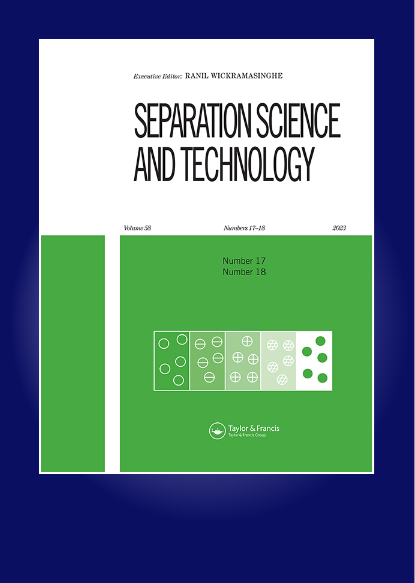Solvent extraction of acetic acid from aqueous solutions: A review
IF 2.3
4区 工程技术
Q3 CHEMISTRY, MULTIDISCIPLINARY
引用次数: 0
Abstract
ABSTRACT Acetic acid is one of the top commodity chemicals used in various industrial processes. The separation of acetic acid from aqueous solutions is a crucial requirement in the production units. Effective sequestration and recovery of acetic acid is economically beneficial and significant from value addition and environmental protection perspectives. Simple distillation procedures are not usually viable owing to the necessity of a high number of stages and large reflux ratios in the separation column. Several methods such as solvent extraction, extractive distillation, and membrane separation have been studied to retrieve acetic acid from aqueous systems. Of these methods, solvent extraction is preferred due to less consumption of energy and fast mass transfer rates. The efficiency of solvent extraction primarily depends on the solvent chosen for the extraction. The current work is focused on the review of studies that have been extensively carried out for extracting acetic acid from aqueous solutions using various pure solvents and a combination of solvents. The role of modeling and computer-aided simulation studies in the design and evaluation of separation performance is elucidated. Strategies to enhance acetic acid extraction such as salting-out and buffering-out are highlighted. Future prospects are identified to develop sustainable separation systems.水溶液中乙酸的溶剂萃取研究进展
醋酸是各种工业过程中使用的顶级商品化学品之一。在生产装置中,从水溶液中分离醋酸是一项至关重要的要求。有效的封存和回收醋酸具有经济效益,从增值和环保的角度来看具有重要意义。简单的蒸馏程序通常是不可行的,因为在分离柱中需要大量的级和大的回流比。研究了溶剂萃取、萃取精馏和膜分离等几种从水溶液中提取乙酸的方法。在这些方法中,溶剂萃取是首选的,因为它消耗的能量少,传质速度快。溶剂萃取的效率主要取决于萃取所用的溶剂。目前的工作重点是对使用各种纯溶剂和溶剂组合从水溶液中提取乙酸的研究进行了综述。阐述了建模和计算机辅助仿真研究在分离性能设计和评价中的作用。着重介绍了盐析、缓冲等提高乙酸提取效率的方法。确定了发展可持续分离系统的未来前景。
本文章由计算机程序翻译,如有差异,请以英文原文为准。
求助全文
约1分钟内获得全文
求助全文
来源期刊

Separation Science and Technology
工程技术-工程:化工
CiteScore
6.10
自引率
3.60%
发文量
131
审稿时长
5.7 months
期刊介绍:
This international journal deals with fundamental and applied aspects of separation processes related to a number of fields. A wide range of topics are covered in the journal including adsorption, membranes, extraction, distillation, absorption, centrifugation, crystallization, precipitation, reactive separations, hybrid processes, continuous separations, carbon capture, flocculation and magnetic separations. The journal focuses on state of the art preparative separations and theoretical contributions to the field of separation science. Applications include environmental, energy, water, and biotechnology. The journal does not publish analytical separation papers unless they contain new fundamental contributions to the field of separation science.
 求助内容:
求助内容: 应助结果提醒方式:
应助结果提醒方式:


